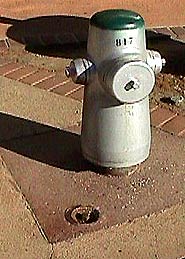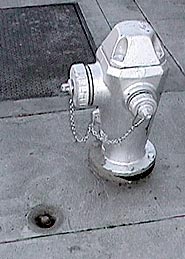
|
|
The Fresno experience with Simple Dry Barrel Fire Hydrants with separate butterfly mainvalves. |

|
|
The Fresno experience with Simple Dry Barrel Fire Hydrants with separate butterfly mainvalves. |
| Text © 2000 Jim Quist |
|
Fresno's dry barrel hydrants are unique in that they do not have integral main valves, but are instead controlled by butterfly valves located in the horizontal part of the bury. The operating nut is therefore located in the hydrant base pad, and is operated by a "T" handle wrench. This approach simplifies parts inventories, but was initiated in the 1970's as a response to the inefficient Perkins wet riser hydrants which were formerly specified by the city. As Byron Beagles, Senior Fire Prevention Inspector with the Fresno Fire Department explains: "Do to low staffing levels, management of the fire ground is more efficient when engines lay from the fire hydrant to the fire using 4˝" or 5" large diameter hose for pump suction. In a city with water pressures of 40-50psi, additional hydrant friction loss is not desirable." To sum up: The advantages of a simple dry barrel hydrant with separate mainvalve are lower initial cost, dramatically reduced parts inventories, and good fire flow characteristics. The downside is that the water department has reported some leaking butterfly valves, and these must be dug up for repair or replacement. The city of Fresno is currently investigating the use of gate valves, or moving to a conventional dry barrel design. It is noteworthy that the simple dry barrel idea is also the standard in other parts of the world, such as Hong Kong. A simple dry barrel hydrant is also sold by the Barbará Company in Brazil. |
|
Left: This simple dry barrel model is a design from the 1970's manufactured by the Apollo Foundry in California. Center: Close-up showing the ground level operating nut. Right: The current Fresno specification is this special version of the venerable Clow F2500. Photos © 2000 Danny Barlogio. |



|
|
|
|
|
| Unless otherwise noted, all contents of these WWW pages © FireHydrant.org |